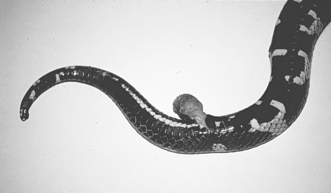Chapter 45 Diseases of the Reproductive System
SNAKES
Dystocia
TREATMENT
• Percutaneous ovocentesis—aspirate the contents of the egg through the ventrum of the snake to decrease the size of the egg
Oviduct/Cloaca (Colon) Prolapse
Prolapse occurs with prolonged straining to pass eggs or fetuses, but it may also be caused by excessive straining for any reason (Fig. 45-1). With a shell gland/oviduct prolapse, the shell gland/oviduct will have a lumen but no feces will be present (as opposed to a prolapse of the colon with feces), and longitudinal striations appear on the surface of the shell duct that are not present on the colon.

Figure 45-1 Prolapse of the hemipenis in a California Kingsnake.
(From Mader DR: Reptile medicine and surgery, ed 2, St. Louis, 2006, Saunders, by permission.)



